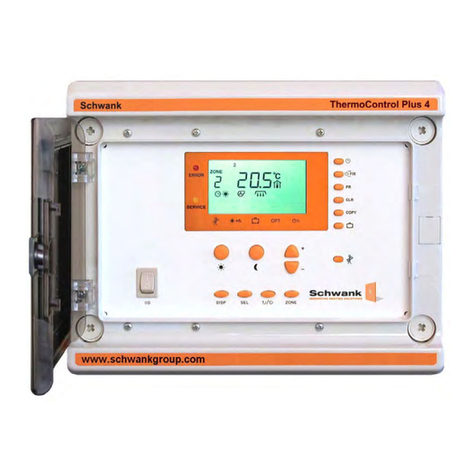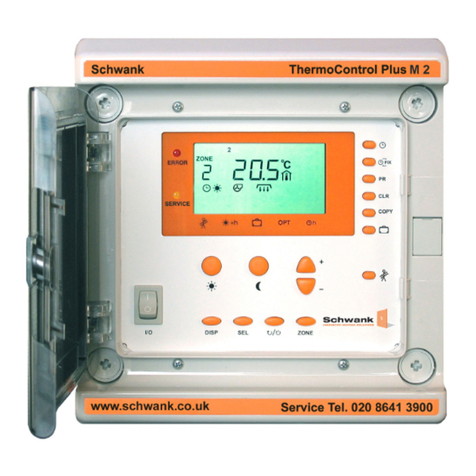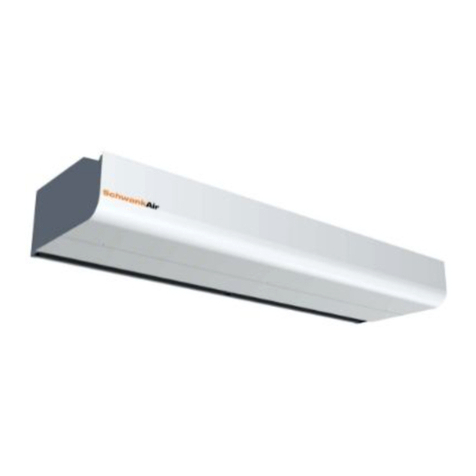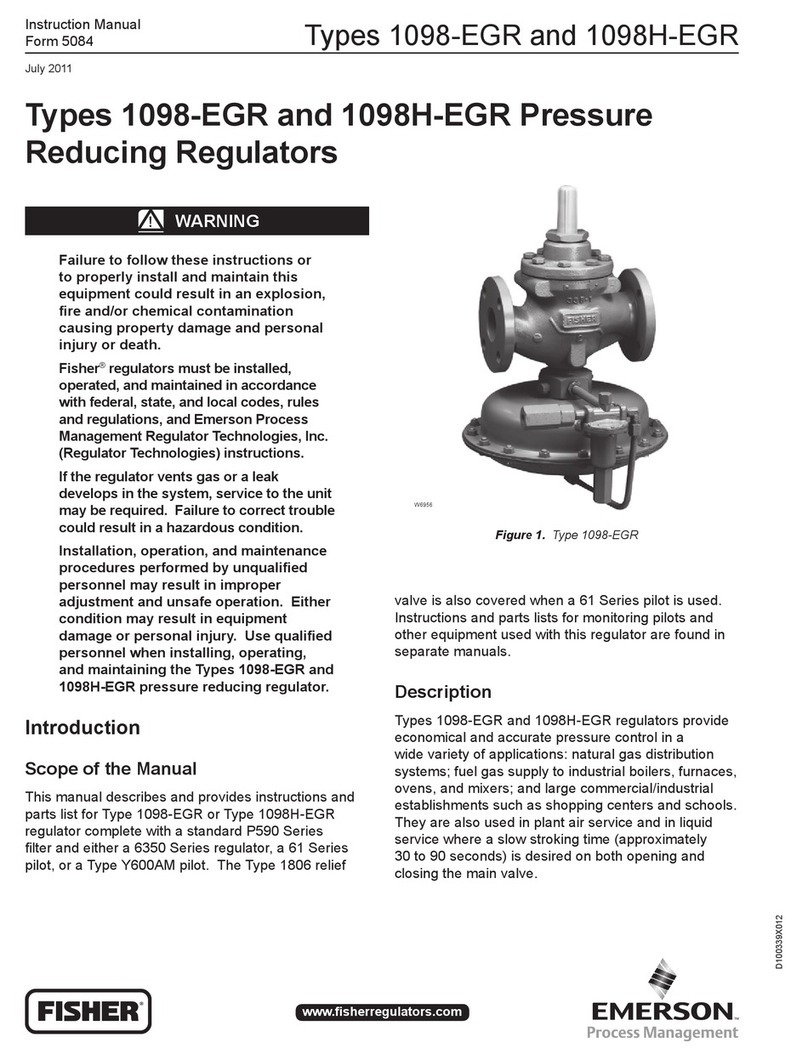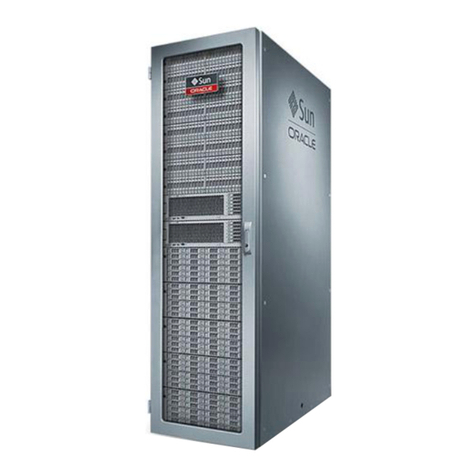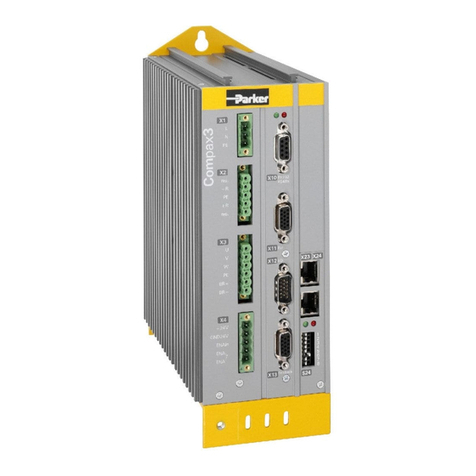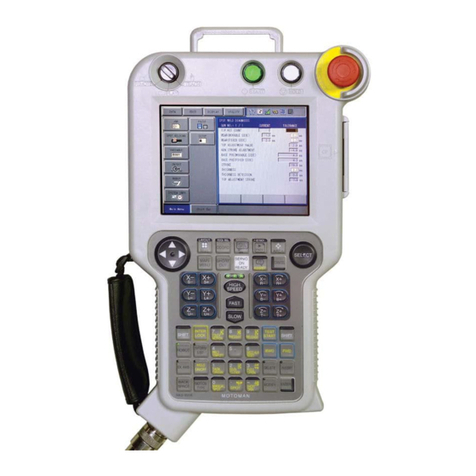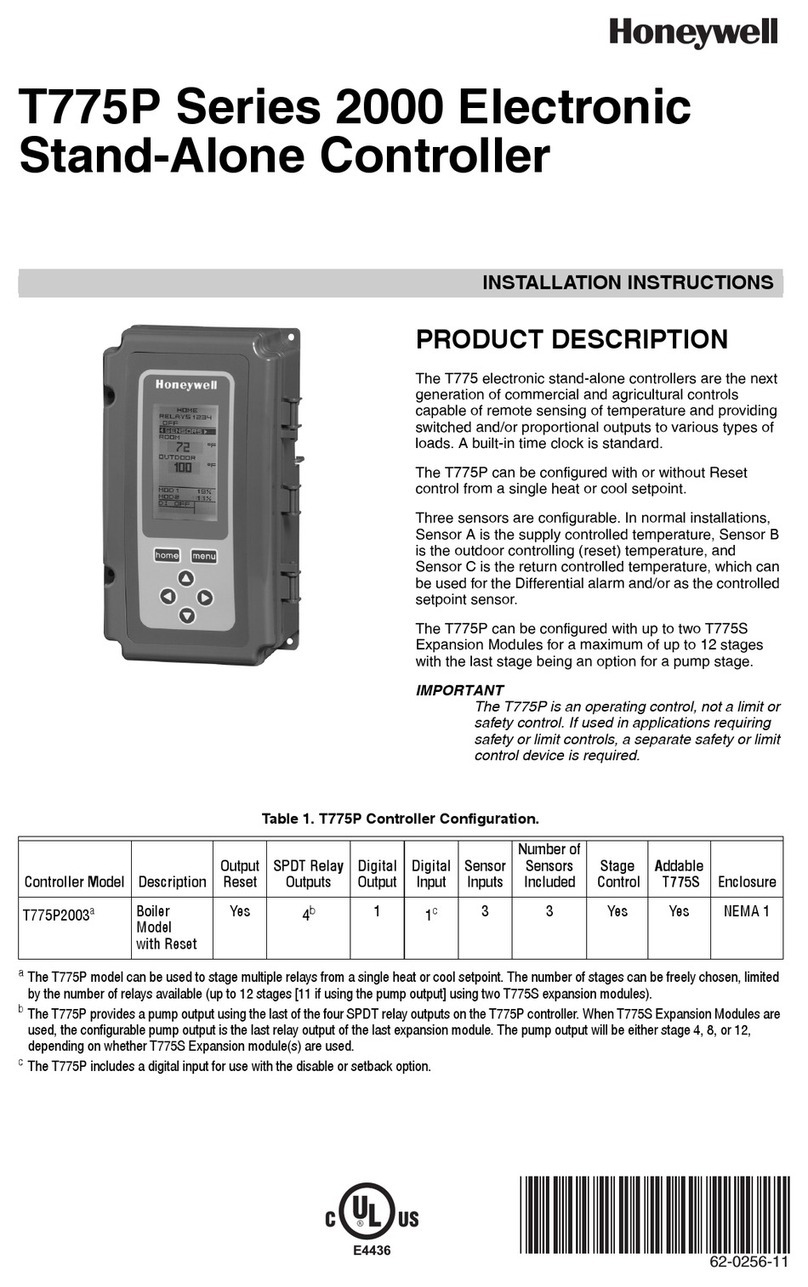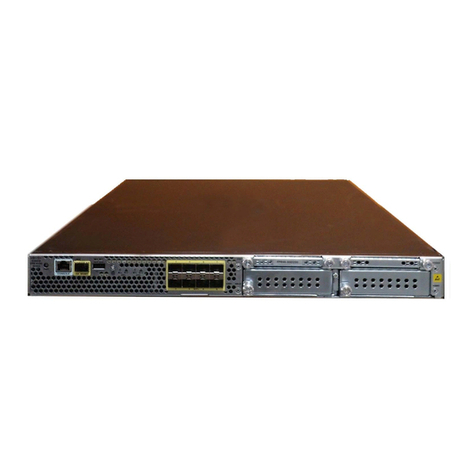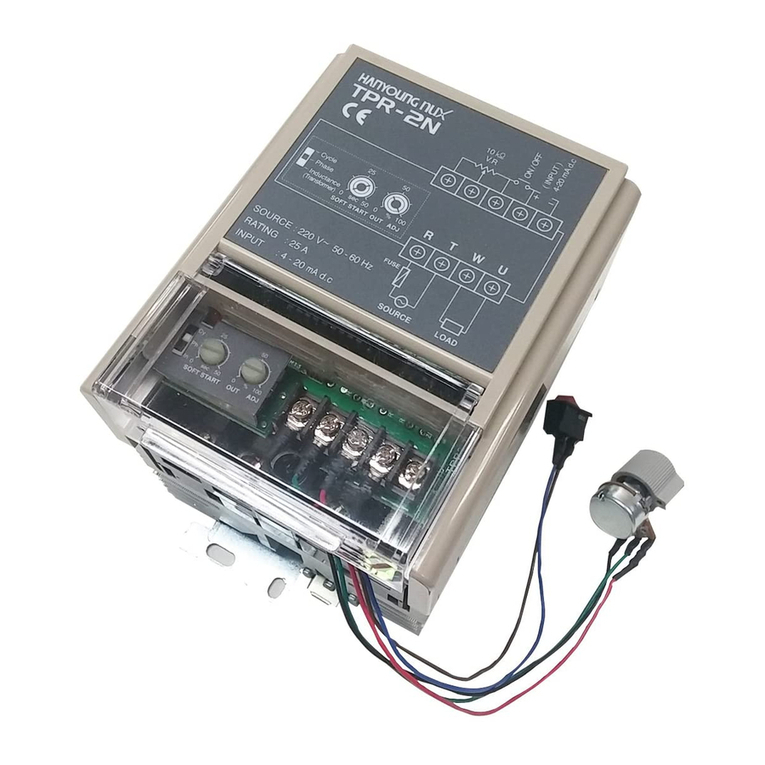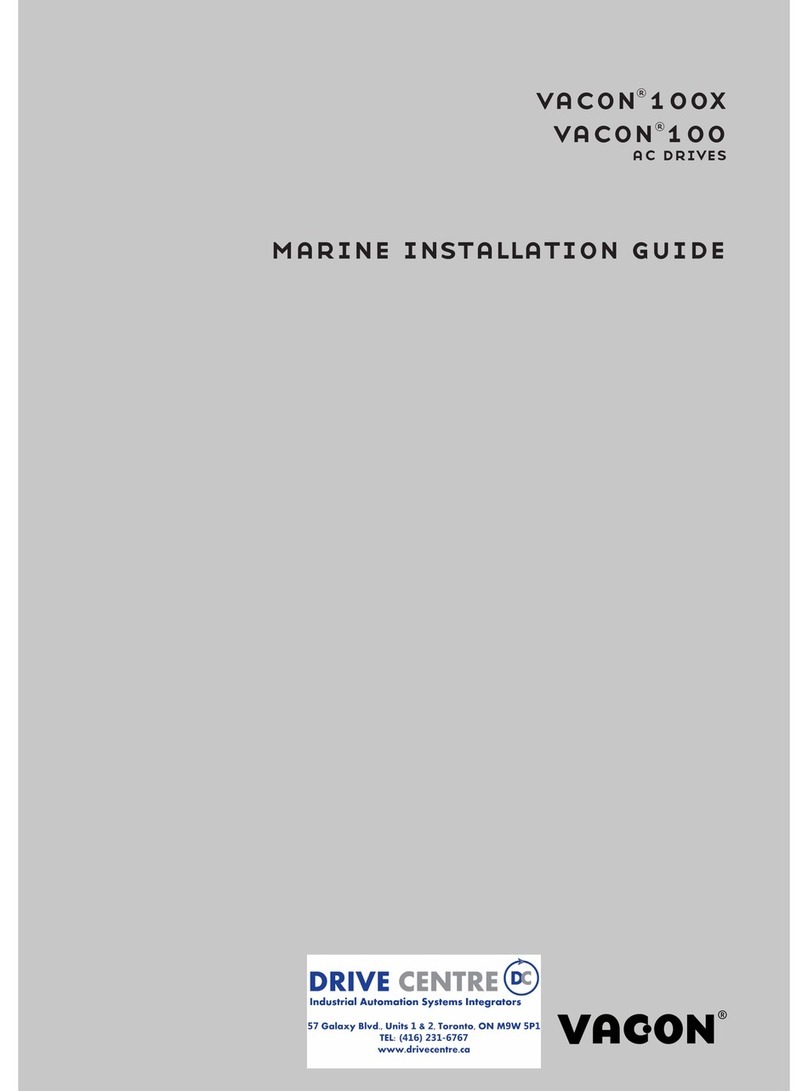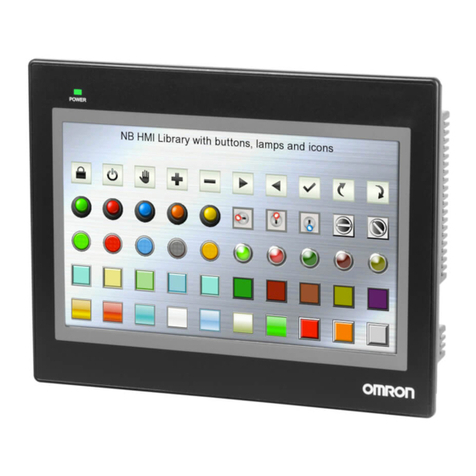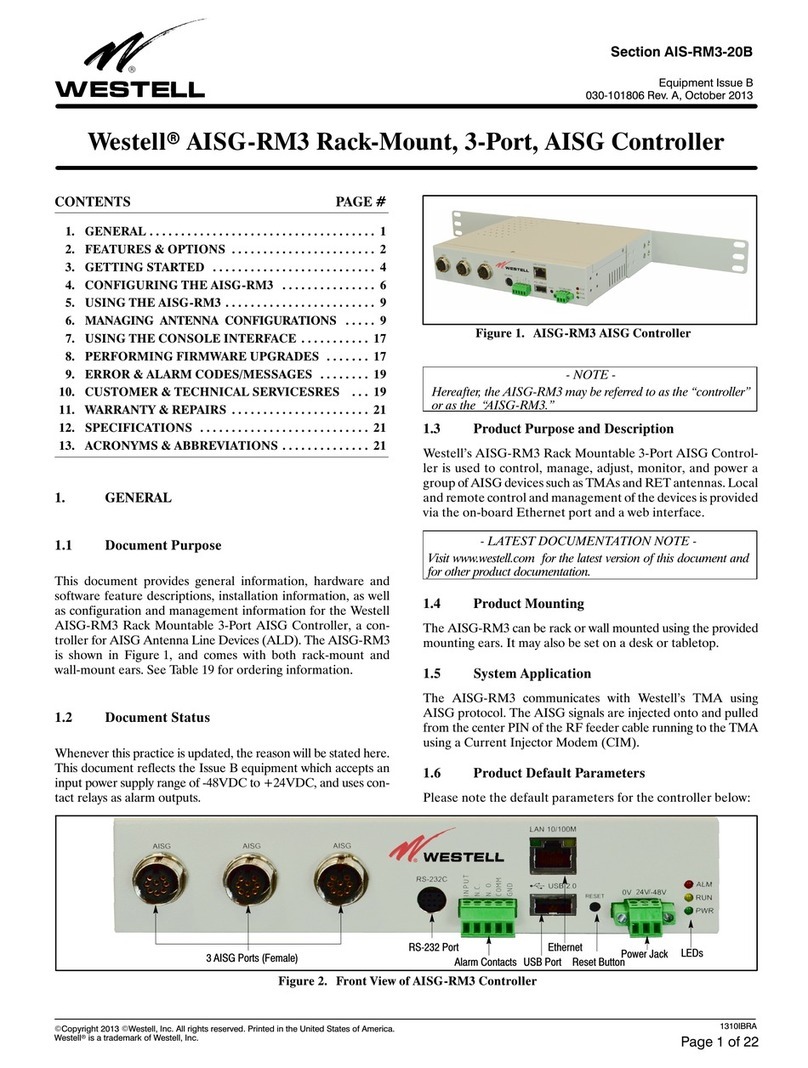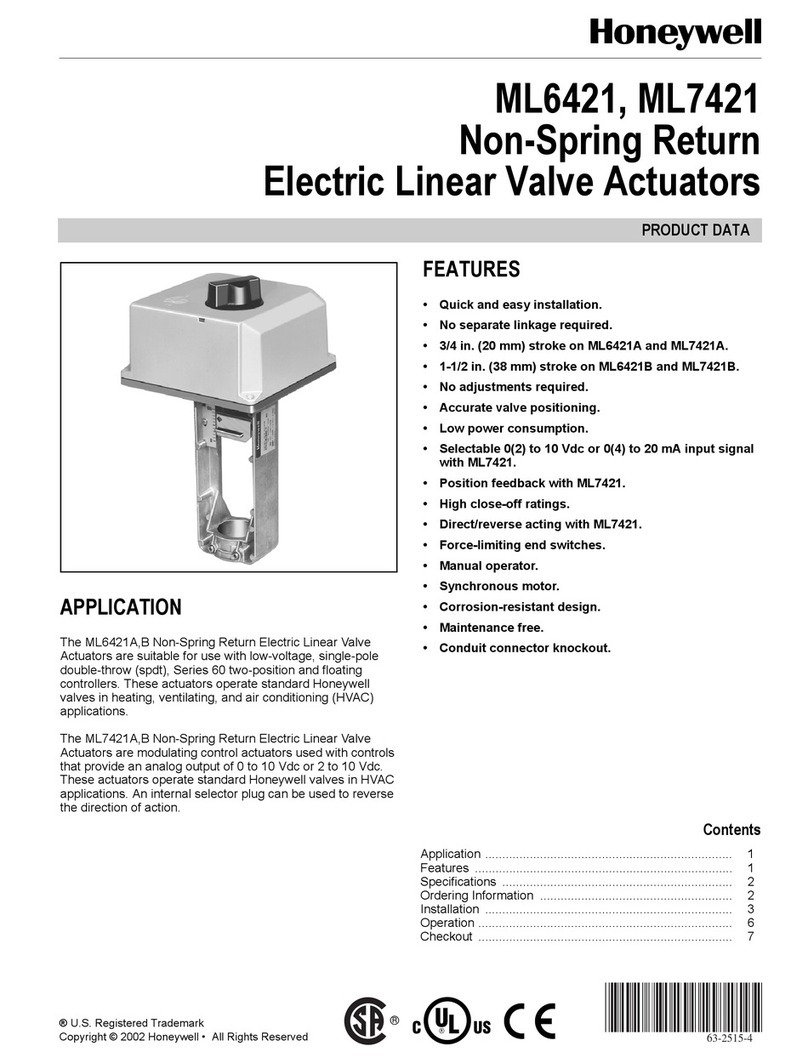Schwank ThermoControl Plus 4 User manual

ThermoControl Plus 4
Eight controller circuits 1-stage
Four controller circuit 2-stage
Operating and
Installation Manual
Schwank Group
P.O.Box 988 2 Schwank Way @ Hwy. 56N
Tel:1-877-446-3727 Fax: 1-866-361-0523
www.schwankgroup.com IM100630
RL:2
JUNE2010

- 2 -
Content:
1 INTRODUCTION ............................................................................................... 4
2 SAFETY ............................................................................................................. 5
3 Display and Button Function .............................................................................. 6
4 OPERATION ..................................................................................................... 7
4.1 Basic operation .......................................................................................... 7
4.1.1 Further display information ........................................................................ 7
4.1.2 Selection of a control zone ......................................................................... 8
4.1.3 Activation and deactivation of a control-zone ............................................. 8
4.1.4 Special information in the base display ...................................................... 8
4.2 Display and change of occupied / unoccupied temperature ....................... 9
4.3. Display and modify time and date ............................................................ 10
4.4 Circuit/Zone Times ................................................................................... 12
4.4.1 How to display and read a zone time program ......................................... 12
4.4.2 How to clear a switch point ...................................................................... 13
4.4.3 How to clear a time program .................................................................... 13
4.4.4 How to protect the time program .............................................................. 13
4.4.5 Program the switch points ........................................................................ 14
4.5 Holiday program ....................................................................................... 15
4.6 Manual operation
FI
X
............................................................................ 16
4.7 Button for service maintenance mode ...................................................... 16
5 SET UP THE OPERATING PARAMETERS .................................................... 17
5.1 Enter the number of control zones ........................................................... 17
5.2 Set up system operation parameters ....................................................... 18
5.3 Adaptive heat recovery time .................................................................... 19
5.4 COPY ....................................................................................................... 20
5.5 Securely save or reload all parameters .................................................... 20
6 INSTALLATION ............................................................................................... 21
6.1 Electrical Supply ...................................................................................... 21
6.2 Sensor Connections ................................................................................. 22
6.3 Heater Connection ................................................................................... 22
Zone Configuration Diagrams
6.4 Standard Tube Heaters (single fire rate) .................................................. 22
6.5 Two-stage Tube Heaters ......................................................................... 23
6.6 Luminous Heaters .................................................................................... 23
6.6.1 Luminous Heaters - Jumper P1 ............................................................... 24
6.6.2 Luminous Heaters - Jumper P2 ............................................................... 25
6.6.3 Luminous Heaters - Jumper P3 ............................................................... 26
6.6.4 Luminous Heaters - Jumper P4 ............................................................... 27
6.6.5 Luminous Heaters - Jumper P5 ............................................................... 28

- 3 -
6.7 Exhaust Fan Output - Two-stage Luminous Zones .................................. 29
6.8 Alarm Contact Input ................................................................................. 29
6.9 Remote-Control .................................................................................. 29
6.10 Signal input fault ...................................................................................... 29
6.11 Temperature display ºF / ºC selection ...................................................... 29
6.10 Communication connection (CM232, CM485) ......................................... 30
6.11 Common fault signals .............................................................................. 30
7 TECHNICAL PARAMETERS ........................................................................... 31
8 WIRING DIAGRAMS ....................................................................................... 33
8.1 Standard Tube Heaters: single- and two-stage zones ............................. 33
8.2 Two-stage Tube Heaters: two-stage zones ............................................. 34
Two-stage Tube Heaters: Internal Burner Wiring ..................................... 35
8.3 Luminous Heaters: single-stage zones .................................................... 36
8.4 Luminous Heaters: two-stage zones ........................................................ 37
8.5 Wiring Diagrams: Overrides, Humidity Control, Temp. Averaging ........... 38
8.6 Temperature Sensor Characteristics ....................................................... 39

- 4 -
1 Introduction
The Schwank ThermoControl Plus 4 is suitable for single or two-stage gas-infrared heating
systems.
Dependant upon its operation the controller has one or two controller circuits.
Please read this manual carefully before installing or using the control-unit. Failure to follow the
notes and warnings will affect your guarantees. They are also a prerequisite for a professional
installation and correct handling.
Please pay special attention to chapter 2 “Safety“.
The ThermoControl Plus 4 is designed to be used for industrial/commercial building infrared
heating systems only. Other or further uses are not suitable.
Schwank will not be held responsible for any damages whatsoever resulting from incorrect use.
The controller measures the radiant and ambient temperatures in the space and switches the
heater(s) on/off by relays.
The controller features different operating programs.
-P1…P5: single- or two-stage controller for luminous gas-infrared heaters and tube heaters
Override day temperature mode +h
Available as a special optional feature is a setback override bu tton that manually extends the
programmed heating period. This bu tton is installed parallel to th e sensor. By pushing the button
(~1 sec.), the nominal value of the programmed temperature in t he selected control circuit is
maintained for an additional programmable time period. (Default 1h)
Programmed temperature values and operating programs
The temperatures and operating programs of each single control circuit are independently
selectable.
- Day- , night- or anti-freezing temperature , selected by a week program
- Continuous day-( FIX) night-( FIX) or anti freezing temperature ( FIX).
- Holiday program: the controller is able to save eight holiday periods, which are programmed
according to the calendar.
Other Tools/Features:
– Illuminated display
– Selectable ºF / ºC temperature display
– Button for service maintenance operation mode
– Real-time clock with calendar, including automatic summer / winter time correction
– Outdoor temperature sensor (SA)
– ‘Smart’ adaptive recovery: based on outdoor temperature, adjusts system ramp-up to ensure the
desired occupied temperature is achieved at the programmed time.
– Remote controlled day-mode operation
– ‘On’ cycle record at each output
– Error-relay: relay switches on in any case of error

- 5 -
2 Safety
This is a 24VAC Class 2 low voltage
(24Vac) temperature controller. Use
only Class 2 rated power supply. Do
not install on voltages higher than
30Vac.
Read all information in this manual
before installing or programming the
appliance. Electrical installation and
wiring must conform to local and
national building and electrical
codes. Check the electrical
equipment regularly. Defective wire
etc. must be replaced immediately.
Be sure that power routed to the
controller has been powered ‘off’
before beginning installation or
installation of communication
modules. Lock out the power supply.
The Schwank ThermoControl Plus 4
must be mounted where it is not
affected by vibration or shock.
The feed/supply line must be
protected by the installer with a fuse
of maximum 16 A.
Install the ThermoControl Plus 4
ensuring conformity to the wiring
diagram located in the switchboard.
Minimum Wiring Connection:
It is the installer’s responsibility
to ensure that wire gauge is
sufficient to provide 24Vac from
the transformer to the controller,
and from the controller 24Vac
outputs to the external relays
that power heaters and exhaust
fans. The distance between the
power source and equipment
must be considered.
24Vac power from 100VA
transformer to the controller
with minimum 16 AWG wire
24Vac from controller outputs
to equipment power relays
with minimum 16 AWG wire
Connect sensor to controller
with minimum 18 AWG wire
Install the IR temperature sensor
between the radiant area of two
heaters at a height of 6 ft (2 m)
above floor. In this location the
controller receives the optimal
value of the comfort temperature
(radiant temperature plus
ambient temperature).
NOTE: If heating zones are dimensionally
large in size or there are extreme
temperature gradiants within the
zone, temperature averaging can
be achieved using four IR sensors
wired in parallel-series for each
zone.

- 6 -
3 Display and Button Function
Front panel layout:
1. I/O Main switch on / off
2. LCD Display: All functional and operating information is shown in the base display mode
(upper picture). If no button is pushed for more than one minute, the control unit
switches back to the base display.
3. Push the button or the button to display the day or night set value. Use the +/-
buttons to modify the values.
4. + / - With these buttons the display values can be increased or decreased.
5. DISP “Display-button“: To change the di splay. This button also offers the ability to switch back
to the main menu immediately.
6. SEL “SELECT”: This button allows selection of a certain parameter shown in the display. The
chosen/selected parameter can be modified using the +/- buttons.
7. Clock-button: display and modify time and date.
8.
FI
X
Toggles between programmed and FIXED modes.
9. PR To check and modify the weekly time program in the displayed control circuit.
10. CLR “Clear-button“: To delete a switch-point or a complete time program.
11. Copy This button can be used to copy time- and temperature programs.
12. ERROR The system-error lamp flashes for any kind of error. An flashing sign will provide
information about the cause.
13. ZONE To switch between different control circuits.
14. To turn on/off the single control circuit.
15. SERVICE “Maintenance”: If this appears, please call your service professional.
16. Button to program holiday operation mode.
17. Button for service maintenance operation mode: all control circuits heat full load.

- 7 -
4 Operation
4.1 Basic operation
When starting the ThermoControl wit h the I/O -button an automatic disp lay-test is activated. The
controller starts with the factor y default program. The display then switches to the base-program,
which shows all the important operation information.
4.1.1 Further display information
Actual control mode, in
this case: day
mode Present status of the heater zone:
full load
partial load (only 2-stage control)
heater is turned off
Measured temperature
in the space/zone
(18.2°C)
The exhaust fan is
working (optional)
Indication of the
chosen control circuit
Indication of which relay output and which
sensor inputs are used in the specific
control circuit.
Display of the outside te mperature (only if an
outdoor temperature sensor SA is connected).
‘On’ cycle counter: The 2-stage control shows the
circuit time of both stages.(1,2).
Push the SEL button to
switch between the
stages. The data cannot
be deleted, after 999999
hours the display
switches back to zero.
The main/base display give s all important operating
data, further information can be received by pushing
the DISP button.
Value of the entered freeze protection temperature .
The displayed value can be changed by the +/-
buttons. Range of setting: +3 ... +20 °C / 37 ...68 ºF

- 8 -
4.1.2 Selection of a control zone
4.1.3 Activation and deactivation of a control-zone
To stop heating in a certain zone: select the zone, and push the button. The symbol will
indicate the deactivation of the zone. In the deactivated zone only temperature measurement and
display continue to work. Activate the control zone again by pushing the button.
4.1.4 Special information in the base display
The controller display and its usage is
based on the display of the control
circuit. The control zone can be
selected by pushing the ZONE
button. All settings of the control zone
can be managed.
During adaptive heat recovery (optimised heat time) the
OPT symbol appears. The activati on time of a specific
zone is dependent on the hi story of preheating
performance compared to the entered heating time. This
function can be deactivated onl y in the setup-menu. An
outside sensor SA is required for this feature.
While using the holiday-mode the
symbol will
appear.
To stop or modify the holiday program push the
button (chapter 4.5).
Option: By pushing the override button the occupied
temperature mode starts for a pre-programmed time (0:00-
24:00h; default 1h). The +h symbol will appear. The
override mode can be stopped by using the
FI
X
button.

- 9 -
4.2 Display and change of occupied/unoccupied temperature
The desired temperature for each control circuit can be programmed separately
The temperatures can be
changed within the range:
+3…+35 °C / 37 ...95 ºF
Push the DISP button to switch the current display
back to the main displa y (automatic after one
minute if no button pushed).
The current
occupied/unoccupied
temperatures can be
displayed by pushing or
button.
The values can be modified
by pushing +/-.
All modifications are saved
immediately.

- 10 -
4.3. To display or modify the base time and date of the controller
Cycle through the base time and date of the controller with the button. Modify any time or date
using +/-.
This function affects the base controller clock (all control circuits have a separate time program).
Push the button to display/modify time of day (in the picture: 14:03). Push the button again
to display/change the year (2007). Push the button a third time and the month and day (in this
case: 3rd month = March, 21 st day) is displayed. In the upper display, “3 Day” indicates the third
day in the week, or “Wednesday”. ( 1= Monday, etc.)
Push the button once more to switch the display back to the full normal clock display.
Press the DISP button to return to the base display,.
Setting the time and date
NOTE: symbols or figures, shown framed are blinking!
Month Day of
Month
Day of Week
To change the time
press the SEL button.
First the minutes start to
blink (03). Modified
using +/-.
After pushing the SEL
button again, the hours
will start to blink. (14)
The hour can also be
changed with the +/-
buttons.
The time of day setting
is completed using the
button.
The display returns to
the year.

- 11 -
Set the year
After the time of day has been modified, set the correct year, month and day as well. Otherwise the
automatic summer / winter time correction won’t work properly.
Set the month and day
To change the year press the
SEL button. The last two
figures will start to blink (06).
Modify with the +/- buttons.
Next push the button and
month and day of the month
respectively will be shown on
the display. When the year
has been modified, the day of
the week may change
according to the calendar (in
this case 3).
To change the setting press
SEL. First the month (3) will
start to blink - modify the setting
with +/-.
To change the day of the month
push the SEL button again.
Now, the date starts to blink
(21). Modify the date using +/-.
Once more the day of the week
changes according to the
calendar (first fr om 3 to 6, then
to 7).
When the time/date setting is
complete push DISP. The
display switches back to the
base display.

- 12 -
4.4 Circuit/Zone Times
Each control circuit has an independent time program, which can be set or modified.
The time program is a series of different circui t times. The controller changes automatically from
occupied (day) mode , to unoccupied (night) mode or freeze protection mode-
A circuit/zone point of time to switch modes can be described as:
- time of day (hour and minute)
- temperature mode , or , which will start at the set point of time
- day of the week, or a number of days, when the switch mode time should be active
(1 = Monday, 2 = Tuesday ……7=Sunday)
- number of switch modes points of time (max. 19 times in one program)
4.4.1 How to display and read a zone time program
From the base display, to see the time program in the selected zone push the PR button.
The display will then jump to the first programmed switch point. Press the PR button repeatedly to
display the stored switch points one by one. Over the symbol the number of the switch point is
displayed. The upper part of the display " 1 2 3 4 5 Day" indicates which days of the week ( 1=
Monday…) the switch function occurs. With a few presses of the PR button you can see the full
weekly heating program. Two examples are shown here:
At switch time point 1 (7:00)
day mode heating is
started. Then at switch time
point 2 (17:30) night mode
heating begins. Since these
two switch time points are
valid on the first five days of
the week (1 2 3 4 5 Day)
and there are no other
programmed switch time
points for the last two days (6
7) the entire weekly program
is described with these two
switch time points.
In this next example the
program is extended with
two additional points: on
Saturday ( 6 Day) at the
point 3 (8:00) day mode
heating starts. At point 4
(12:45) frost protection
mode begins. This mode
will be active until the next
programmed point 1 is
reached on Monday.
When you first press the PR
button the display will briefly
show the number of free switch
point locations (here:17 free
points).

- 13 -
4.4.2 How to clear a switch point
The numeric of a switch point is not fixed. If a switch point is deleted the numbers of the remaining
points will be reassigned so that there is no chance of gaps in the time program.
4.4.3 How to clear a whole time program
4.4.4 How to protect the time program
The function of the time program is based on the clock and calendar data.
The clock is supplied by a batte ry (1.5 V AA). A warning signal shows, when the battery needs
replacement. For a 2 minute period while changing the battery, the exact time and date will remain
intact.
In case the control-unit is not used for a long ti me, including a complete discharge of the batteries,
the time and date will require confirmation of correctness or resetting after a battery change.
The saved switch points are independent of the battery. The pr ogram is saved on a secured
EEPROM-memory . Time programs cannot be lost as a consequence of a battery change or
discharge.
To clear a whole time program
push and hold the CLR button
while the number of free spaces
are shown in the display (FrEE).
The symbol CLR will start to
blink as a warning. If the CLR
button is released immediately,
then the erasure procedure will
be stopped.
If the erasure is completed
horizontal lines are visible. Then
the new number of free switch
points is displayed.(19).
To clear or erase a switch time
point: select the point, push and
hold the CLR button. The
symbol CLR will blink in the
display, warning that a switch
time point is to be cleared. If the
CLR button is released
immediately, then the erasure
procedure will be stopped.
If the erasure is completed
horizontal lines are visible. Then
the new number of free switch
points is displayed.

- 14 -
4.4.5 To program the switch points
In this example we program the following criteria: The day
temperature should start every morning at 7:35 from Monday
through Friday. First search for a free switch point ( - -:- -) by using
the PR button. Then press the SEL button and +/- to modify the
new data. The same procedure ca n be used to modify existing
switch points.
At first the temperature mode
starts to blink. The mode
or can be selected using
the +/- buttons.
Then press the SEL
button to select the day
program. The entire
week appears: 1234567
Pressing +/- selects
different day groups or
only single days
(1=Monday).
Next press the SEL button to
modify the hour of the day
(12). The required time (7) can
be set with +/-.
Then press SEL to select the
minutes (00). The required
time (35) can be set with +/-.
Finally press the PR button to
set the switch time program.
The display then changes to
the next free switch point.
It is not possible to program two different switching points with the same time parameter. In the
case of a mistake saving two switching points for the same time, t he time of the last
programmed point will be corrected by one minute.
In this case a new switch point
was programmed with a time of
7:35. This time parameter was
used previously in switching
point 3. Thus the time for point 4
changes automatically to 7:36.

- 15 -
4.5 Holiday program
The controller provides the opport unity to program 8 holidays. Start and end of the holiday is
displayed with exact data (year, month, day). The programs can be c hanged and also stopped at
every point of time.
During the holiday program the freeze protection temperature will be maintained.
To program holiday periods push the
button.
First the number of the holiday program HOL 1 (holiday 1) appears. The numeric above the
holiday number shows which of the 8 holiday programs is activated. A programmed holiday period
starts automatically at the programmed date. Within the SEL button you are able to start or stop
the programmed holiday period. If the program is switched off (program number does not appear)
it won’t start, a running program would be shut down respectively. Use +/- to select one of the 8
holiday programs.
The holiday program activates in all control circuits that are set to the automatic mode . If a
control circuit is working on a fixed mode (FIX), the holiday program does not come into effect.
Push the
button again to modify the start of the
holiday period (A): by pressing +/- you can set up year,
month and day.
The holiday program starts off at 0.00 o’clock on the
desired date.
After modifying the start (A), you will have to set up the
end (B) of the holiday period. To set the date use the
+/- button. The holiday program ends at 0.00 o’clock on
programmed day.
Press
button to finish programming, the display
switches back to HOL.1. Now you can select the next
holiday program and start its modification, otherwise
you can get back to the main display by pushing the
DISP button.
The ERR symbol can appear while you are programming
a holiday:
- if start date A is later than the programmed end of the
holiday period B
- if the end of the period B is earlier than the present
date.
A program that indicates one of these problems won’t
start.
If all errors are eliminated the ERR –symbol disappears.

- 16 -
4.6 Manual operation FI
X
Use the
FI
X
button to select different operating modes.
4.7 Button for service maintenance mode
To change the FIX
mode push the
FI
X
button.
Press DISP when the desired operation mode
appears (for example: continuous FIX mode). The
control-unit switches back to the main display and the
selected mode is activated.
night-temperature mode
day-temperature mode
freeze protection temperature
For service or maintenance, to have the heater(s) in full
operation regardless of the current room temperature, push
the button. Switch back to the base display mode by
pushing this button again.
Push
FI
X
to return to the main display.

- 17 -
5 Set up the operating parameters
The “setup” switch as well as the jumper selection of the program P1 … P5 may only be
changed after the main power to the controller has been switched off. Before you open the
control unit read the important information in chapter 2! The set up of operation parameters
can be modified from the front panel with the “setup” switch in the “On” position. Only a trained
and knowledgeable technician should modify the operating parameters. After setting up the
operation parameters, turn off main power and switch the “setup” switch to the “Off” position to lock
the parameters.
To access the setup switch: The switch permit setup: “ON”, locks the setup: “OFF”.
Switch off the main electrical supply before changing the switch position between
“On” and “Off”. It is not sufficient to switch off the I/O switch on the front panel of the
controller, the external main switch must be switched off to avoid electric shock or possible
damage to the module.
Open the case cover door and loosen the four big plastic screws at the corners to release
the outer enclosure case.
Setup switch is located inside the outer enclosure case to the left side of the battery.
The application program is selected at the controller unit (P1, P2, P3, P4, P5). Perform this
operation with the main power supply switched of. Place the “jumper“ in the correct position. Only
one program can be selected at any one time. Double check that the jumper is positioned for the
correct application program!
If the application program is changed (jumper moved) after set up, all parameters switch back to
the default factory setting (chapter 5.1 and 5.2)!
P1 - Eight control circuits, single-stage
P2…P5 - Variations of control circuits - combines single- and two-stage zones
5.1 Enter the number of control zones
The controller is able to manage one or two control zones, depending on the chosen application. In
the following example the actual number of control zones are set.
Push the DISP button to return to the normal functions.
Hold the ZONE button for about 3
sec.. The number of available
control circuits appears in the
display (for example.: 1-8: four
control circuits). The desired
number of control circuits can be
selected by pushing +/- (1-7).
- All zones single-stage
- 1 zone 2-stage, up to 6 single-stage
- 2 zones 2-stage, up to 4 single-stage
- 3 zones 2-stage, up to 2 single-stage
- 4 zones 2-stage

- 18 -
5.2 Set up system operation parameters (suggested settings are circled)
To set up the parameters hold the DISP button
for approximately 3 seconds. The “PAr” symbol
appears briefly. The operation parameters can
be selected with the SEL button.
Proportional Gain: Two-stage mode
only: 0.5...3.0 °C / 1.0...5.5 ºF
Suggested Setting: 1.0°C / 1.8°F
In single-stage mode: (--.--) appears
Integration time: Two-stage mode
only: 10 … 99 minutes
Suggested Setting: 30 minutes
In single-stage mode, or in off-state
(--.--) appears.
Hysteresis , can be activated by
0.2 … 2.0 °C / 0.4...3.6 ºF
Suggested Setting: 0.7°C / 1.2°F
Sensor correction: if the sensor could
not be mounted at the optimal location,
the measured temperature can be
revised: -9.9..+10.0 °C / -9.9..+10.0 ºF
t1: Heater starts and runs at full power
then stops at the programmed time, in
this case: 0…5 minute.
t2: For the displayed time, the heater
stops completely (5..60 Sec). it only
appears, if t1 doesn’t equal zero.
Minimum heater run time: ( 0...15
min)
Suggested Setting: 5 minutes
Ability of a restart:
t3: Set to “0” for single stage heaters,
set to “1” for 2-stage heaters. Heater
starts at full load for 1 minute, then the
controller switches to the regular mode
(0: off). It does not appear unless the
two-stage control is selected.
Override Duration: +h (0:00-
24:00)
Suggested Setting: 1:00 hour
1.8°F
1.2°F
Single stage heaters
in 2-stage system 2-stage heaters

- 19 -
5.3 Adaptive heat recovery time
The adaptive heat recovery time is active only if the sensor Outdoor Ambient Temperature Sensor
OAS is connected to the controller, and the function is programmed to “Auto” in any heating zone.
Each control circuit has a separate and individual adaptive heat recovery time. When set to “Auto”
the program works automatically and doesn’t need to be programmed or adjusted. The controller
‘learns’ and switches on the system to achieve occupied temperature at a different time than
originally programmed, so that the desired temperature is achieved at the required time. The
heating characteristics of the heating zone and temperature difference from inside to the current
outside temperature are integrated in the calculation for the recovery time. The control unit adjusts
the start point of the recovery time to the current situation.
Exhaust fan post-purge time :
After a heating zone (two-stage
luminous) has been switched off, the
exhaust fan can continue to run until
the set time is achieved: 0 to 60
minutes (available only in the ”AUto”
ventilation mode).
Adaptive (Optimized) heat recovery
time can be switched on (AUto) or
off(OFF). The effective warm up time
is shown.
Auto switch summer to winter time
(+/- 1h).
This function can be activated (AUto)
or deactivated (OFF).
If a communication module is integrated into the controller, other parameters will follow.
Switch off exhaust fans:
’AUto’: exhaust fan in use = for two-
stage luminous zones ONLY,
’OFF’’: exhaust fan output is switched
off for all tube heater zones, and
single stage luminous zones
(the symbol disappears).
Display illumination duration:
1…..9 minutes; enable (ON) or
disable (OFF) display illumination.
Feature selection of the contact
input no. 72-73:
: remote contact
RES-ERR: signal input - Error
Refer to sections 6.4 to 6.7 for
exhaust fan output use

- 20 -
5.4 COPY
The COPY button offers the opportunity to copy all parameters of a certain circuit or the complete
time program and insert it into the program of one or many other control circuits.
5.5 To securely save or reload all parameters:
The setup technician can save all operational parameters to memory. If the parameters are
changed unintentionally, the old parameters can easily be re-established using the data saved in
memory. It is also possible to reload the factory default settings.
To Save: Press CLR and +
simultaneously. The “SAVE”
symbol appears in the display.
Push DISP, the display will blink
while the parameters are saved.
Once saved the display
switches back to the main
menu.
To Load: Press CLR and SEL simultaneously, the
“LOAd” symbol appears in the display. Press the DISP
button and the parameters that were saved by the setup
technician, will reload. Switch from “LOAd” to
“FACt“, using the +/- button. If “FACt” appears in the
display push the DISP button to re-establish the factory
default parameters.
To copy parameters hold DISP (approx. 3 sec.,
chapter 5.2).
To copy time programs use the PR button (chapter.
4.4.1).
This example copies data from Zone 1 to Zone 2.
Push either the DISP (parameters) or PR (time
program) button
Zone 2 symbol start to blink. “COPY“ appears in the display
to indicate the copy mode. Push COPY to paste the Zone 1
data to Zone 2 (heating area 2).
The data of Zone 1 is now also located in Zone 2. The
Zone 2 symbol stops blinking to indicate the completion of
the copy process.
The data can continue to be copied to other Zones by
selecting Zone 3 to Zone 8 using the SEL button.
To finish copying the parameters press DISP button, or
press the PR button to finish copying time programs.
This manual suits for next models
2
Table of contents
Other Schwank Controllers manuals
